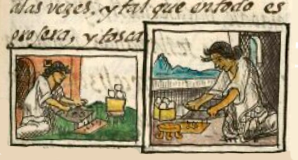tlacualchiuhqui (FCbk10f38r)
This iconographic example, featuring a cook (tlacualchiuhqui), is included in this digital collection for the purpose of making comparisons with related hieroglyphs. The term selected for this example comes from the page previous to the page with the image in the Digital Florentine Codex. There is no gloss, per se. This example shows a woman in one of her traditional occupations, to prepare food (tlacualli or neucayotl). Here, she is grinding dried maize kernels (tlaolli) to make corn dough for tortillas (tlaxcalli), tamales (tamalli), and the like. The basket (chiquihuitl) on a stool probably contains tamales. She grinds the kernels with a hand-held stone (metlapilli) on a large, sloping grinding stone (metlatl). As with so many of her labors, whether cooking or weaving, she is kneeling (verb: motlancuaquetza). She wears a white cotton tunic (huipilli) and skirt (cueitl), which is shaded by the artist here for a three-dimensional effect (showing European artistic influences). Her hair is in the traditional style (neaxtlahualli or axtlacuilli) of an adult woman, with the points above the forehead.
Stephanie Wood
Something like the huipil and skirt were symbols strongly associated with women’s culture, the mano and metate maize grinding setup (as it is called in Mexican Spanish) had such an association. But manos and metates are still rare in this digital collection (as of September 2025). One example of a metate, below, was used as a phonetic indicator for the name Magdalena. For some reason, grinding bowls (e.g., tecaxitl) and sauce grinding bowls (molcaxitl) are more prevalent.
Stephanie Wood
Tlagualchiuhgui
tlacualchiuhqui
Stephanie Wood
1577
Jeff Haskett-Wood
manos, metates, tecajetes, molcajetes, comida, cocineras, cocinar, maíz, tamales
tlacualchiuhqui, a cook, https://nahuatl.wired-humanities.org/content/tlacualchiuhqui
la cocinera
Stephanie Wood
Available at Digital Florentine Codex/Códice Florentino Digital, edited by Kim N. Richter and Alicia Maria Houtrouw, "Book 10: The People", fol. 38r, Getty Research Institute, 2023. https://florentinecodex.getty.edu/en/book/10/folio/38r/images/0 Accessed 10 September 2025.
Images of the digitized Florentine Codex are made available under the following Creative Commons license: CC BY-NC-ND (Attribution-NonCommercial-NoDerivs 4.0 International). For print-publication quality photos, please contact the Biblioteca Medicea Laurenziana ([email protected]). The Library of Congress has also published this manuscript, using the images of the World Digital Library copy. “The Library of Congress is unaware of any copyright or other restrictions in the World Digital Library Collection. Absent any such restrictions, these materials are free to use and reuse.”







